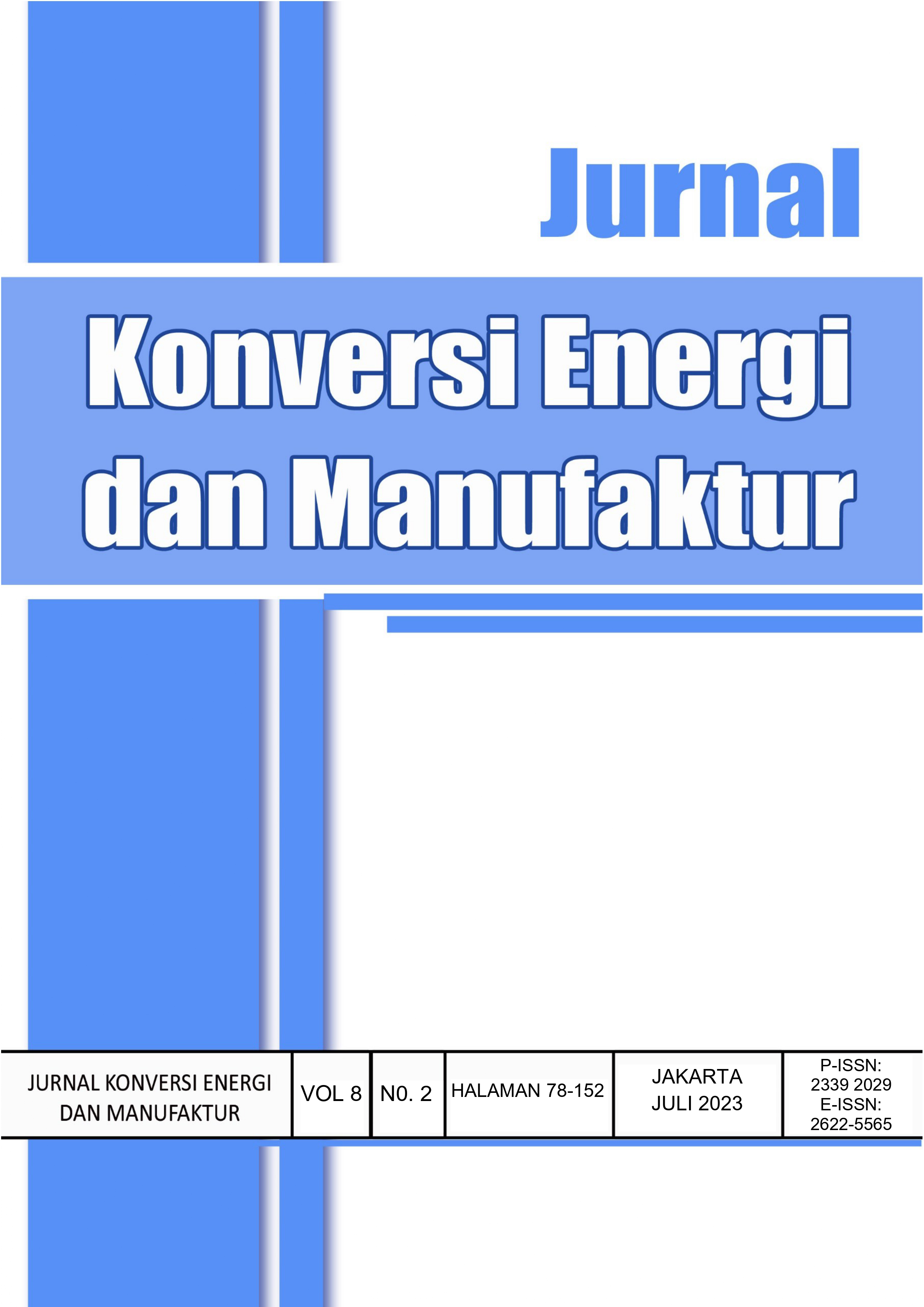ANALISIS TEGANGAN EKUIVALEN FENDER BENTUK SETENGAH PIPA DAN BENTUK PELAT H PADA KAPAL MENGGUNAKAN METODE ELEMEN HINGGA
Analysis of Equivalent Stress on Half-Pipe and H-Plate Shaped Fenders on Ships using Finite Element Method
DOI:
https://doi.org/10.21009/JKEM.8.2.1Keywords:
Fenders, Stress Analysis, Ship, Dock, Finite Element MethodAbstract
Fenders are structures installed on the edges of ships to protect the ship's hull from impact with the dock. The main function of fenders is to absorb the collision energy generated by the ship's impact during berthing at a dock. The load applied to fenders on each ship results in stress distribution in the surrounding hull area, which can lead to various issues such as damage, cracks, deformations, and others. Additionally, the presence of fenders with different shapes can affect the stress distribution values in the surrounding hull area. Hence, a local stress analysis using finite element method software is necessary. The analysis focuses on static loads originating from the ship itself when docked at a port. However, only the fender section is analyzed, and it is not necessary to consider the entire ship's body. The objective of the analysis is to determine the stress characteristics and maximum stress values in the fender itself. The analysis results reveal that the highest stress value occurs in the half-pipe-shaped fender with a value of 0.22809 MPa. Based on these findings, it can be concluded that the stress values in the fender meet the allowable standards. In conclusion, this analysis provides an understanding of stress and the maximum stress value in ship fenders. This knowledge is crucial to ensure that fenders effectively fulfill their function of protecting the ship from impacts with docks.
References
[2] Fauzan, " Perencanaan Fender Dermaga (Jetty) Kapal dengan Bobot 10000 DWT," Ensiklopedia of Journal, vol. 1, no.1, pp. 153-157, 2018
[3] A. I. Bachtiar, Marimin, L. Adrianto, and R. O. Bura, "Strategi Peningkatan Daya Saing Industri Perkapalan," Jurnal Aplikasi Manajemen dan Bisnis, vol. 7 no. 1, pp. 121-134, 2021, doi: 10.17358/jabm.7.1.121
[4] I. I. Rezaldy "Analisis Tegangan pada Fender Kapal Tipe Setengah Pipa dengan Fender Tipe M menggunakan Metode Elemen Hingga," Tugas Akhir Universitas Pembangunan Nasional Veteran Jakarta Fakultas Teknik Program Studi Teknik Perkapalan, 2022.
[5] Z. Ukhrawi, "Analisis Kekuatan Impak Fender pada Kapal Laut dengan Variasi Penampang menggunakan Metode Elemen Hingga Berbasis Software Abaqus," Tugas Akhir Departemen Teknik Mesin Fakultas Teknik Universitas Hasanuddin Gowa, 2021.
[6] M. D. Bestari, D. Setyawan, and M. N. Misbach, "Analisa SCF (Stress Concentration Factor) menggunakan Pendekatan Numerik pada Pelat dengan Fillet Asimetris akibat Beban Tarik," Jurnal Teknik ITS, vol. 10, no. 1, pp. G1-G7, 2020, doi: 10.12962/j23373539.v10i1.59243.
[7] R. K. N. Suprapto, and L. A. N. Wibawa, "Desain dan Analisis Tegangan Rangka Alat Simulasi Pergerakan Kendali Terbang menggunakan Metode Elemen Hingga," Jurnal Teknik Mesin ITI, vol. 5, no. 1, pp.19-28, 2021, doi: 10.31543/jtm.v5i1.559.
[8] S. O. Dapas, "Aplikasi Metode Elemen Hingga pada Analisis Struktur Rangka Batang," Jurnal Ilmiah Media Engineering, vol. 1, no. 2, pp. 156-160, 2011.
[9] H. Suryanto, "Aplikasi Metode Elemen Hingga untuk Analisa Struktur Statik Linier dengan Program MSC/Nastran," Working Paper Universitas Negeri Malang, 1999.
[10] R. Ramadani, H. Prastowo, and S. P. Fitri, "Analisa Tegangan pada Vertical Subsea Gas Pipeline akibat Pengaruh Arus dan Gelombang Laut dengan Metode Elemen Hingga," Jurnal Teknik ITS, vol. 4, no. 2, pp. G-15-G-19, 2015, doi: 10.12962/j23373539.v4i2.11755.
[11] M. A. Naiborhu, "Evaluasi Kapasitas Eksisting Pelabuhan Bongkar Batubara terhadap Peningkatan Ukuran Tonase Kapal," Jurnal Teknik Transportasi Trisakti, vol. 1, no. 1, pp. 58-69, 2020, doi: 10.54324/jtt.v1i1.430.
[12] R. Gunawan, A. S. Aisjah, and A. A. Masroeri, "Perancangan Sistem Kontrol Sandar Kapal Otomatis Berbasis Logika Fuzzy di Pelabuhan Tanjung Perak Surabaya," Jurnal Teknik ITS, vol. 2, no. 2, pp. E55-E62, 2013.
[13] A. T. Metzger, J. Hutchinson, and J. Kwiatkowski, "Measurement of Marine Vessel Berthing Parameters," Marine Structures, vol. 39, pp. 350-372, 2014, doi: 10.1016/j.marstruc.2014.10.001.
[14] Biro Klasifikasi Indonesia, dalam Biro Klasifikasi Indonesia, Indonesia, pp. 13. 2017.
[15] Trelleborg, "Fender Design," Swedia: Trelleborg Marine System, 2007.
[16] T. A. M. Syahputra, “Desain Fender pada Condensate and Shulphuric Acid Berth PT.Pertamina-Medco E&P (Job PMTS) di Senoro Block Project,” Tugas Akhir Jurusan Teknik Kelautan Fakultas Teknologi Kelautan Institut Teknologi Sepuluh Nopember Surabaya, 2015.
[17] U. Shigeru, H. Toshihiko, and S. Satoru, "Statistical Design of Fender for Berthing Ship," The Twelfth International Offshore and Polar Engineering Conference, 2002.
[18] H. L. Fontijn, "On the Prediction of Fender Forces at Berthing Structures Part II: Ship Berthing Related to Fender Structure," In: Bratteland, E. (eds) Advances in Berthing and Mooring of Ships and Offshore Structures. NATO ASI Series, Springer, Dordrecht, pp. 95-166,1988.
[19] K. Yu, P.Yan, and J. Hu, "Numerical Analysis of Blade Stress of Marine Propellers," J. Marine. Sci. Appl, vol. 19, pp. 436–443, 2020, doi: 10.1007/s11804-020-00161-3.
[20] G. Neşer, and D. Ünsalan, "Dynamics of Ships and Fenders during Berthing in A Time Domain," Ocean Engineering, vol. 33, pp. 1919-1934, 2006, doi: 10.1016/j.oceaneng.2005.10.020.
[21] ASTM A36/A36M-19, Standard Specification for Carbon Structural Steel, ASTM International, West Conshohocken, PA, 2019.
[22] ASTM A572/A572M-18, Standard Specification for High-Strength Low-Alloy Columbium-Vanadium Structural Steel, ASTM International, West Conshohocken, PA, 2018.






















